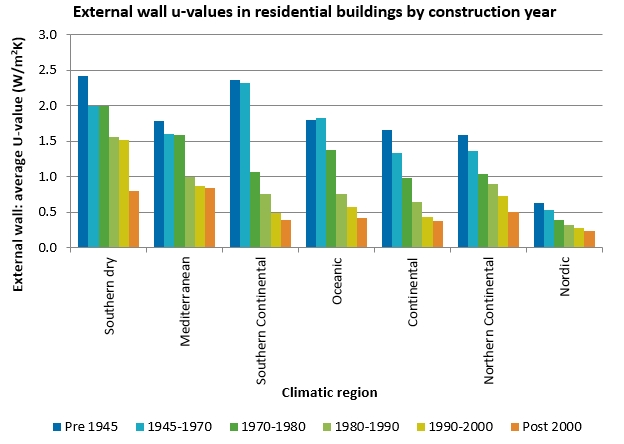INSPiRe renovation solutions for residential and office buildings

|

|
There is an increasing need to upgrade the existing building stock and improve building performance, which is particularly important if the targets for reduced energy consumption that have been set by Energy Performance of Buildings Directive (EPBD) are to be achieved.
BSRIA is currently one of 24 partners involved in a 4-year EU-funded research project called iNSPiRe. The objective of iNSPiRe is to tackle the problem of high-energy consumption by producing systemic renovation solutions that can be applied to residential and office buildings. The renovation packages developed as part of the iNSPiRe project aim to reduce the primary energy consumption of a building to less than 50 kWh/m2/year.
Early on in the project it was realised that further knowledge of the existing building stock was required before renovation packages could be developed. One of BSRIA’s tasks was to undertake a literature survey on the current state of the residential and office building stock across Europe. This involved gathering information and data related to the number of dwellings, floor areas, ownership profiles, typology, construction materials, structural and thermal characteristics and energy use of these buildings. Energy consumption and demand data was further broken down by space heating, domestic hot water, cooling and lighting requirements.
The survey revealed the concentration of both residential and office space in the ‘big six’ countries of France, Germany, Italy, Poland, Spain and United Kingdom means that from an EU-wide perspective it will make most sense to identify building retrofit solutions that suit these countries first and foremost. These six countries account for 72% of residential and 71% of office floor area.
A further finding was that across the EU-27, single family houses represent the majority of the heated floor area at 60%. This means that to be effective across the whole residential stock, retrofit solutions need to be designed to accommodate both single and multi-family houses.
In general, the level of owner-occupation across the EU-27 is high. In some countries (Bulgaria, Lithuania, Romania) it can be greater than 90% and in most countries it is higher than 70%. High levels of owner occupation can be helpful for retrofit projects, as one of the key barriers to retrofit measures that reduce energy consumption is where the costs are borne by the landlord but the benefits are seen by the tenant. However, there are other challenges associated with retrofitting owner-occupied properties that are easier to overcome in social housing, particularly in multi-family houses.
The thermal performance of building elements has improved in all EU-27 countries since 1945, with the most dramatic improvements since 2000. Clearly some countries that are in the coldest climates have always had good thermal insulation and countries in the hottest climates used to have poor thermal insulation. In terms of targeting fabric retrofit measures, older dwellings give more potential for improvement. This is good because over half the residential stock in the EU-27 countries was built before 1970.
U-value data for wall, floor, window and roof elements were collected for each country and further broken down by age. The graph below shows the average wall U-values weighted according to the floor areas in each country per climatic region.
Total heating energy consumption across residential and office sectors is approximately 2,299 TWh/year and 159 TWh/year respectively, giving a ratio of 14:1. This underlines the importance of the residential sector in energy-reduction retrofit. However, the variability of the buildings in the residential sector means that this segment of the market is also harder to treat with standardised solutions.
The data used in this project was obtained from a literature survey covering previous research projects, energy agencies, census outputs and databases. The availability of detailed data, particularly for the office buidling stock was often limited.
A categorisation process using building types and climatic regions was applied to the findings from the building stock survey. Using this approach a number of target buildings were identified.
The established target buildings are currently being used to test the feasibility of the renovation packages being developed. The results are being fed into simulation approaches to investigate the expected energy savings and impacts the solutions will have on the built environment.
The iNSPiRe project will continue until October 2016.
This article has been produced in the context of the iNSPiRe Project. The research leading to these results has received funding from the European Community's Seventh Framework Programme (FP7/2007-2013) under grant agreement n°314461. All information in this document is provided "as is" and no guarantee or warranty is given that the information is fit for any particular purpose. The user thereof uses the information at its sole risk and liability. For the avoidance of all doubts, the European Commission has no liability in respect of this document, which is merely representing the authors view.
The article originally appeared as ‘iNSPiRe and its approach to achieving effective retrofit’ in BSRIA’s Delta T magazine, in January 2016. It was written by BSRIA’s Dr Sarah Birchall.
--BSRIA
[edit] Find out more
[edit] Related articles on Designing Buildings Wiki
Featured articles and news
One of the most impressive Victorian architects. Book review.
RTPI leader to become new CIOB Chief Executive Officer
Dr Victoria Hills MRTPI, FICE to take over after Caroline Gumble’s departure.
Social and affordable housing, a long term plan for delivery
The “Delivering a Decade of Renewal for Social and Affordable Housing” strategy sets out future path.
A change to adoptive architecture
Effects of global weather warming on architectural detailing, material choice and human interaction.
The proposed publicly owned and backed subsidiary of Homes England, to facilitate new homes.
How big is the problem and what can we do to mitigate the effects?
Overheating guidance and tools for building designers
A number of cool guides to help with the heat.
The UK's Modern Industrial Strategy: A 10 year plan
Previous consultation criticism, current key elements and general support with some persisting reservations.
Building Safety Regulator reforms
New roles, new staff and a new fast track service pave the way for a single construction regulator.
Architectural Technologist CPDs and Communications
CIAT CPD… and how you can do it!
Cooling centres and cool spaces
Managing extreme heat in cities by directing the public to places for heat stress relief and water sources.
Winter gardens: A brief history and warm variations
Extending the season with glass in different forms and terms.
Restoring Great Yarmouth's Winter Gardens
Transforming one of the least sustainable constructions imaginable.
Construction Skills Mission Board launch sector drive
Newly formed government and industry collaboration set strategy for recruiting an additional 100,000 construction workers a year.
New Architects Code comes into effect in September 2025
ARB Architects Code of Conduct and Practice available with ongoing consultation regarding guidance.
Welsh Skills Body (Medr) launches ambitious plan
The new skills body brings together funding and regulation of tertiary education and research for the devolved nation.
Paul Gandy FCIOB announced as next CIOB President
Former Tilbury Douglas CEO takes helm.
























